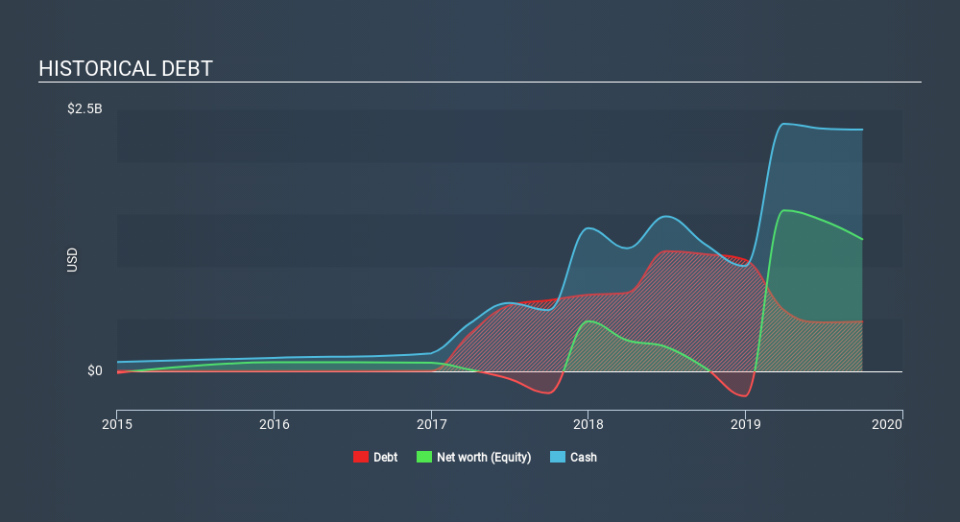Health Check: How Prudently Does Sea (NYSE:SE) Use Debt?

Warren Buffett famously said, 'Volatility is far from synonymous with risk.' So it seems the smart money knows that debt - which is usually involved in bankruptcies - is a very important factor, when you assess how risky a company is. We note that Sea Limited (NYSE:SE) does have debt on its balance sheet. But the more important question is: how much risk is that debt creating?
What Risk Does Debt Bring?
Debt is a tool to help businesses grow, but if a business is incapable of paying off its lenders, then it exists at their mercy. In the worst case scenario, a company can go bankrupt if it cannot pay its creditors. However, a more frequent (but still costly) occurrence is where a company must issue shares at bargain-basement prices, permanently diluting shareholders, just to shore up its balance sheet. Having said that, the most common situation is where a company manages its debt reasonably well - and to its own advantage. The first thing to do when considering how much debt a business uses is to look at its cash and debt together.
See our latest analysis for Sea
What Is Sea's Net Debt?
The image below, which you can click on for greater detail, shows that at September 2019 Sea had debt of US$470.6m, up from US$1.1k in one year. However, its balance sheet shows it holds US$2.31b in cash, so it actually has US$1.84b net cash.
How Strong Is Sea's Balance Sheet?
The latest balance sheet data shows that Sea had liabilities of US$2.05b due within a year, and liabilities of US$770.7m falling due after that. Offsetting these obligations, it had cash of US$2.31b as well as receivables valued at US$140.5m due within 12 months. So it has liabilities totalling US$375.3m more than its cash and near-term receivables, combined.
Given Sea has a humongous market capitalization of US$18.5b, it's hard to believe these liabilities pose much threat. However, we do think it is worth keeping an eye on its balance sheet strength, as it may change over time. While it does have liabilities worth noting, Sea also has more cash than debt, so we're pretty confident it can manage its debt safely. When analysing debt levels, the balance sheet is the obvious place to start. But it is future earnings, more than anything, that will determine Sea's ability to maintain a healthy balance sheet going forward. So if you're focused on the future you can check out this free report showing analyst profit forecasts.
Over 12 months, Sea reported revenue of US$1.7b, which is a gain of 152%, although it did not report any earnings before interest and tax. So its pretty obvious shareholders are hoping for more growth!
So How Risky Is Sea?
We have no doubt that loss making companies are, in general, riskier than profitable ones. And we do note that Sea had negative earnings before interest and tax (EBIT), over the last year. Indeed, in that time it burnt through US$304m of cash and made a loss of US$1.5b. But the saving grace is the US$1.84b on the balance sheet. That means it could keep spending at its current rate for more than two years. Importantly, Sea's revenue growth is hot to trot. While unprofitable companies can be risky, they can also grow hard and fast in those pre-profit years. There's no doubt that we learn most about debt from the balance sheet. However, not all investment risk resides within the balance sheet - far from it. Take risks, for example - Sea has 2 warning signs we think you should be aware of.
Of course, if you're the type of investor who prefers buying stocks without the burden of debt, then don't hesitate to discover our exclusive list of net cash growth stocks, today.
If you spot an error that warrants correction, please contact the editor at editorial-team@simplywallst.com. This article by Simply Wall St is general in nature. It does not constitute a recommendation to buy or sell any stock, and does not take account of your objectives, or your financial situation. Simply Wall St has no position in the stocks mentioned.
We aim to bring you long-term focused research analysis driven by fundamental data. Note that our analysis may not factor in the latest price-sensitive company announcements or qualitative material. Thank you for reading.

